October was filled with sometimes startling changes: one day brilliant color, the next somber brown; one day summer’s blackbirds, the next juncos arriving from the north; one day open blue water, the next thousands of feeding ducks on Lake Carmel. A dry spell persisted yet the nut and berry crop was abundant. Vernal pools, usually filled with autumn rains, were bone-dry and the shores of all Kent’s lakes were expanded.

Winterberry: Ready to swap food for a ride inside a bird. Photo: Beth Herr
10/5 Though officially autumn, my summer wardrobe was enough for a walk in the color-filled woods by the Kent Public Library. I saw yellow and orange leaves backlit by the sun, but green was still the dominant hue. A deep blue sky complimented the display. Crickets were chirping, chipmunks were clucking, blue jays were calling.
10/6 Along my daily walk, I spied a new color – an old stump was covered in a sulphur shelf fungus bloom. The mushrooms proved the hyphae underneath were doing their job of turning dead trees into soil. They were food for squirrel, flies, and others, including me. I recognized this bright yellow-orange mushroom with thousands of pores underneath (not gills). I plucked a few of the soft, cool shelves. Sautéed in butter and olive oil, it earned its common name “chicken of the woods.”

Just waiting to be taken home for dinner. Photo: Beth Herr

Yep, it tastes like chicken. Photo: Beth Herr
10/7 A young bull moose was spotted by many walking in the area between Wingdale and Dover Plains. — Dennis Purdy, June Chutka

It’s bigger in real life. Much bigger. Photo: Dennis Purdy
10/10 All migrating raptors were again struggling in the wind at the Chestnut Ridge Hawkwatch. Their quick passing made them difficult to identify. Sharp-shinned (13) and Cooper’s hawks (12) led the migrant raptors. Non-raptor observations included 335 Canada geese in lots and lots of big “V” formations. — Anna Butler, Brendan Popp
10/12 Town of Fishkill, HRM 63: In a survey of birds at Stony Kill Farm today, house sparrows and starlings were the highest count, but there were also palm warblers and white-crowned, savannah, chipping, and song sparrows in the gardens. Several ravens, a red-tailed hawk, and turkey vultures soared overhead and three killdeer landed in a plowed field. — Deborah Tracy-Kral
10/16 A surprising number of turkey vultures moved through in the late morning at the Chestnut Ridge Hawkwatch, again comprising the majority of our migrants (83%). High counts among raptors were sharp-shinned hawks (11) and Cooper’s hawks (10). Again, a bald eagle was spotted in the morning, heading east. Non-raptor observations included three late-season monarch butterflies. — Tait Johansson, Brendan Popp

Does anyone know what this fungus on a beech tree is? Photo: Beth Herr
10/17 Witch-hazel blooms, the last of the flowers in Kent’s forests this year.
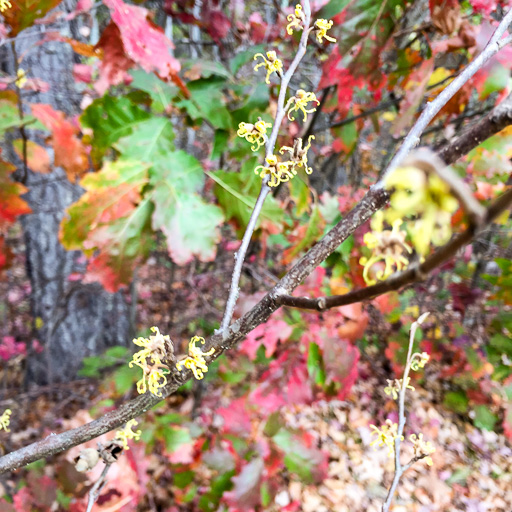
If it’s witch-hazel decoction you need, boil the stems, not the flowers. Photo: Beth Herr
10/18 The last few days’ southerly breezes brought back summer with today’s temp reaching 84°.
10/22 Steady and sometimes heavy rain dumped 2½ inches of rain. It was a relief to hear the rain and to smell damp earth. Perhaps the rain is enough to help the amphibians’ need to settle in for the winter, and also help those that need to breed in woodland pools.
Amphibians (and reptiles) need to find a good overwintering spot, where they won’t freeze. In some cases, that might be a few feet upstream or into a seepage area, and in others it is a few hundred yards uphill. The extent of the migration and the species participating vary in different parts of the state…
Migration often occurs at night, while it’s raining, so as to prevent their skin from drying out. (Amphibians need to have moist skin because a large portion of the frog’s ‘breathing’ occurs via oxygen diffusing through the skin. Oxygen will not diffuse through a dry membrane.) After the very dry summer we’ve had, a large number of amphibians were observed taking advantage of the recent rain and migrating. From the blog Naturally Curious with Mary Holland.
10/23 A ferocious north wind blew.
10/27 Snowfall at daybreak, new and white, quickly changed to a long, sustained downpour. Everything got a good drink. It may have been enough rain to fill woodland pools in Kent and allow our amphibians to move and mate.
10/28 My son Michael has spotted and photographed a greater white-fronted goose on our lake, which currently has about 500 geese on it. — Gordon Douglas
10/28 Rusty blackbirds were raucous and numerous out-competing the howling wind.
10/29 An adult bald eagle roosted across the street from the Kent Town Center.
10/29 Over 70 youngsters joined the fun in the first Little People Walk for Little People, as part of the Halloween Extravaganza at the Kent Public Library. Little people are part of the folklore of many cultures around the world. Whether leprechauns, fairies, trolls, or gnomes, stories of the teeny tiny abound. So haunted houses and fairy lairs were found along the trail in the woods behind the library. After collecting acorns and caps (very easy – there are so many nuts this year) and colored leaves, the kids places their treasures at troll stumps, fairy lairs, leprechaun hideouts. Then, using baskets, sticks, and imagination, everyone joined the fun and made a fairy village. The results linger in our town forest. Here’s a sample:
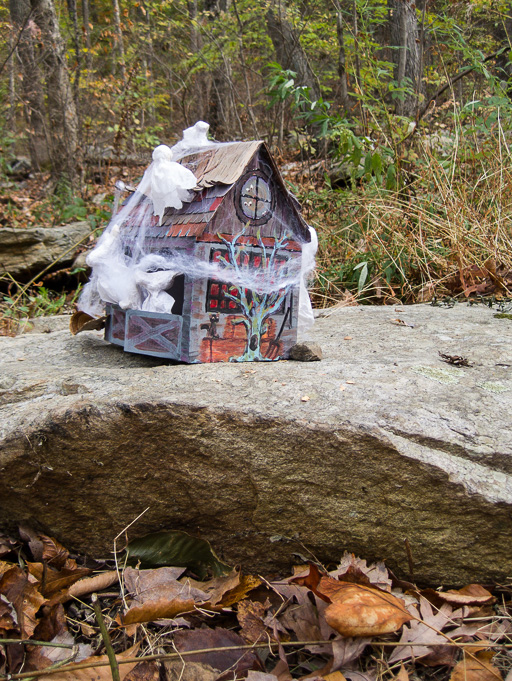
You never know what you’ll find in the woods. Photo: Dave Ehnebuske
10/30 We had a few “confusing fall warblers,” as R.T. Peterson called them. A little flock of myrtle warblers, usually among the latest to leave, moved through recently. There has been a changing of the guard at the bird feeders too, as the winter birds have arrived. Woodpeckers are coming back to the suet, juncos have arrived, a few goldfinches have appeared. Only the voracious house finches continue as before. — Doris Ballant
Ed. note: A great way to keep track of your birds, and contribute significantly to citizen science, is to participate in Cornell’s Project FeederWatch. You can sign up on line.
10/30 Moose reported in Pawling!

Low water at Lake Carmel, a good reason to hope for lots of snow. Photo: Beth Herr
Going into November, rainfall remained deficient. The high water of the East and Middle Branch Reservoirs was deceiving. Lakes lowered while shorelines widened. Most streams ran low and wetlands, typically flooded by November, were bone dry.
11/1 Northern Westchester County: I went for a walk to a nearby small lake and to my delight there were three river otters cavorting in the water. One was larger than the other two. They dove, circled, came up and dove again, and all the while their heads bobbed in the sunlit water. — Irene Marks
11/2 Unseasonably warm weather with 65° days made walking pleasant for people, and living easier for most animals. The hundreds of ducks on Lake Carmel had it easy, too. Lots of sun and little wind gave them feeding berth on the wide lake. The mountain was mirrored in the still water as a great blue heron fed along the shore easily spotting dinner.
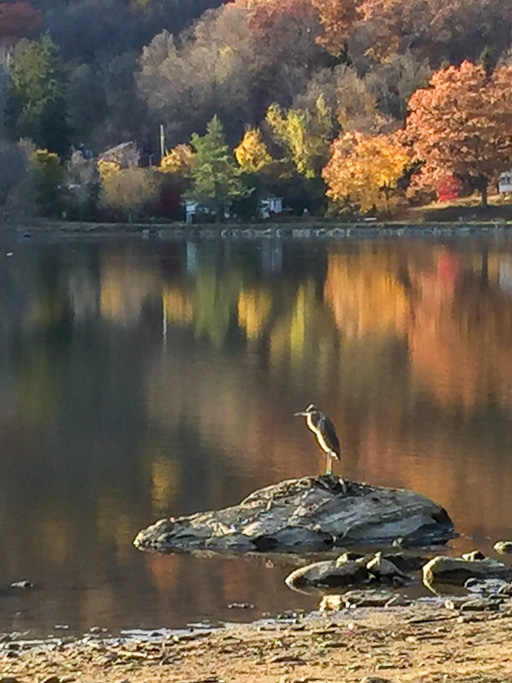
Just lookin’ for dinner. Photo: Beth Herr
11/4 The day began overcast and rainy but by early afternoon the wind shifted to the northwest and the sky turned blue. It turned out to be a flight day! In a half hour of “hawk watching” atop a ridgeline above the river, and with the aid of 10×50 binoculars, we counted six sharp-shinned hawks, five Cooper’s hawks, and three buteos that may have been red-shouldered or red-tailed hawks. Oddly, we saw no vultures. — Tom Lake, B.J. Jackson, Wappinger Falls
11/8 A sunny election day with the air as warm as summer. It was another good day for a walk around Lake Carmel. The shoreline was quite low with sand and mud exposed. That’s a good thing for raccoons and herons who took advantage of the new food available. Also, exposed on the lake edge were hundreds of Chinese mystery snails, an invasive species.

This raccoon was on a mission. Photo: Beth Herr

The arrow doesn’t show where the heron is going. Photo: Beth Herr
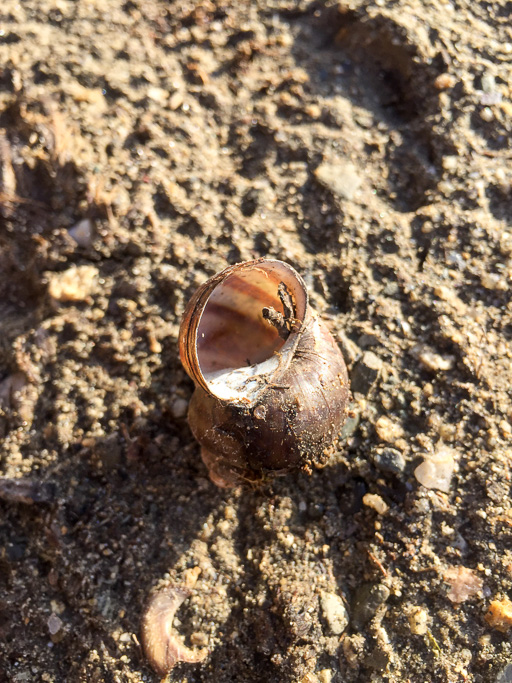
Maybe the heron will eat all you guys. Photo: Beth Herr
11/9 A gray and somber day, with mist and rain throughout the day. Most of the tree leaves have fallen leaving just the brown of the oaks.
11/11 A black bear has been coming to my yard regularly. Even while surveying the damage – such as finding the poles to my bird feeders bent in half – I was not totally certain the culprit was a black bear until I bought a trail cam. The images show a small bear, possibly a cub. (The damage suggests that this one may have had company.) I have since taken down the bird feeders, removed the grease pan from the grill, and secured my trash cans. — Lois Erlacher, Southern Putnam County
11/12 I took a walk on a warm, end-of-fall day in Nimham State Forest today. I enjoyed the last fall colors with the warming sun glowing and clematis seed heads fluffy and beautiful! — Diana Lee
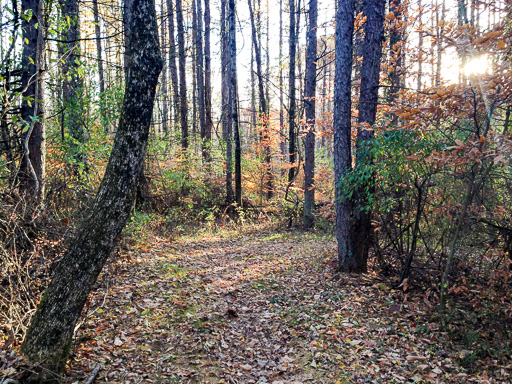
Slanting sunbeams warm Nimham’s last fall colors. Photo: Diana Lee
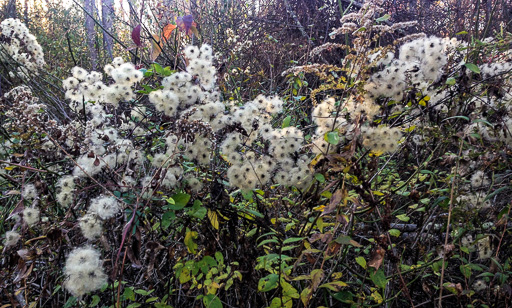
Waiting for the wind. Photo: Diana Lee
11/13 I heard barred owls calling last night on Whangtown Road, and then heard loud screeches/screams. Could there be a barn owl? It would be wonderful to have this declining bird in our area! Saw a fox sparrow – not so unusual – but was surprised to see a lonely redwing under the feeder. — Doris Ballant
11/14 Above 60°, with clear skies, it was a lovely day. The long shadows contrast the warm sunlight with the reality of winter. There are still some ocher leaves around, and the yellows of the Norway Maples to color the landscape. Nuthatches call, woodpeckers work the branches, bitternut hickory nuts roll underfoot.
11/14 On Monday evening, my neighbor Brett and I unfolded two camp chairs by Lake Carmel, set up our cameras, opened our beers and waited for super moon. Then the clouds moved in. An hour later, as we were about to give up, a sudden and momentary parting of the clouds gave us a quick glance. Not the best view, but 2034 is a long way off. — Tore Heskestad

Worth waiting for. Photo: Tore Heskestad
11/16 New York Harbor, Upper Bay: The Coast Guard blasted out a warning to boaters this morning to be wary when sailing around Liberty Island after a whale was sighted near the Statue of Liberty. The whale appeared to be a humpback (Megaptera novaeangliae). — Paul L. Sieswerda, Gotham Whale
11/16 Almost two inches of rain, yay! The weight of the water cemented the brown leaves; the woods’ winter carpet has been installed. The creeks regained their gurgle, and wetland puddles grew.
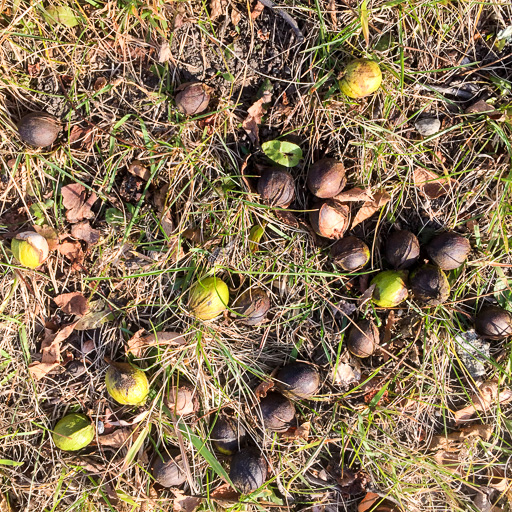
Unlike pecans, their close relatives, bitternuts are, well, bitter. Photo: Beth Herr
11/16 Coming around the corner of the living room I cast the usual glance toward the bird feeder. Accustomed to seeing the squirrels cavorting and the titmice hammering the black oiled sunflower, I was momentarily stunned. Perched atop the deck railing was the Rodan of the local bird world, the wild turkey. Its size dwarfed the feeder and I wondered if the bird enjoyed its dominance and lorded over its domain. Its bird feeder hegemony was short lived as my image was perceived by its eagle eye through the window. The turkey flew down to the ground, rejoined its flock of 15, and the neighborhood pecking order was once again restored. — Ralph Szur

You lookin’ at me, bub? Photo: Ralph Szur
11/17 Strong northerly breezes. Had to hold onto my hat. Activity at the bird feeders was frenzied; chickadees, nuthatches, titmice, woodpeckers, and squirrels visited.
11/19 An inch of precipitation ended in wet snow. Mountain tops got an extra-thick coating making them look like sugar-coated pastries. North of Kent two inches or more glazed and transformed landscapes.
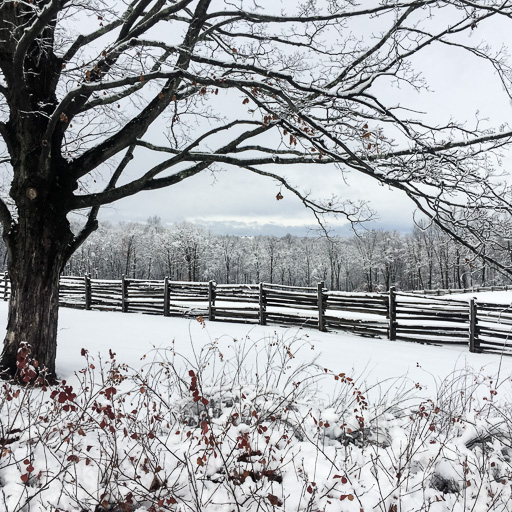
A little snow transforms the landscape. Photo: Beth Herr
11/20 Winds howled a gale from the north and frothed white caps on Lake Carmel, cut power to some Kent residents, kept others inside to stay warm. And so, winter descended and whooshed those mild days away. It was tough for the ruddy ducks and buffleheads on the lakes – most sought the lee of land or small bays. Gulls flocked together on the shore. It was just too rough for them to stay out on the water.
11/25 Rain at the end of a cloudy Thanksgiving Day.
11/25 A short span of clear sky at mid-day was all the sun we had. Clouds hung low and dark, subduing color, softening sound.
11/28 Rain, rain, rain. Yay for nature. But rivulets of water pushed mountains of brown leaves along roadsides, creating puddles that made driving tricky for humans.
11/30 The last two days of November brought over three inches of much needed rain. Everything got a good soaking. Marbled salamander eggs hopefully got covered in pools, the water deficit decreased. All is ready for the coming freeze and thaw.
In December
- Stop by the Kent Public Library and view the month-long exhibition of the winning images from the 2016 Kent Nature Almanac Photo Competition.
- Watch high in the sky for the Geminid meteor shower on December 13-14. The Full Frost Moon on December 14 may outshine the shooting stars. The constellation Orion appears for his winter-long reign.
- Note the winter solstice on December 21, the shortest day of the year, and the increasing day-length thereafter.
- Look for winter color: red partridge and wintergreen berries, bright green mosses and wood ferns, and animal tracks after a dusting of snow.
- Look for old bird nests as the last of the leaves blow away and dried wildflowers that highlight elegant botanical structure.
